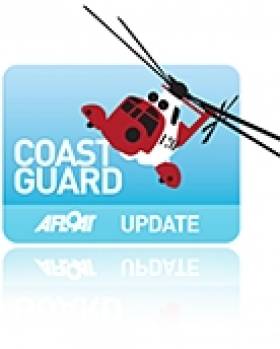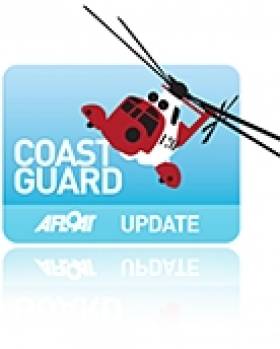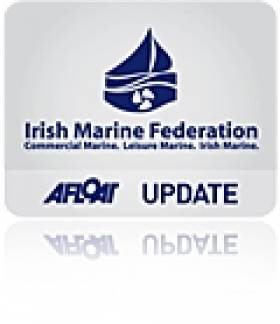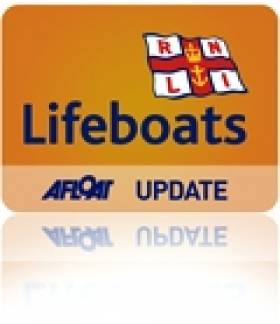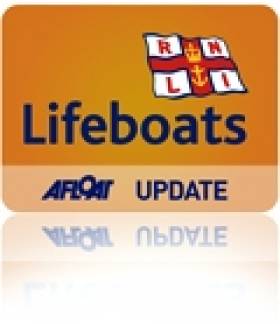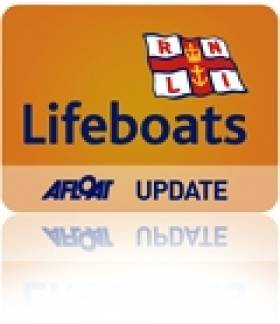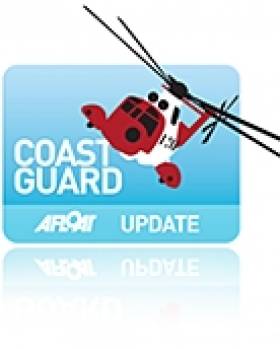Displaying items by tag: Coastguard
Keep Animals Away from Frozen Ponds and Lakes
Belfast Coastguard, in warning the public about venturing out on thin ice said:
"There's no such thing as safe ice. If you do go through the ice, you could face frostbite, hypothermia and ultimately death if you are not rescued fast enough.
"If you're going out anyway in poor weather take your mobile phone with you; because it's cold out there, and you never know when you might need it in an emergency".
"Today in Northern Ireland, a dog drowned after falling through the ice at Enniskillen, Lough Erne. Remember to keep dogs on leads in danger areas, or avoid walking close to frozen lakes, rivers or ponds. Never go in the water after a dog - call the Emergency Services instead.
"If you do fall through the ice, try not to panic. You're going to take a deep breath when you go in, and you're going to suck some water in.
"You have to fight through that and that urge to panic. In that first stage, find something to hold on to whilst you're gasping and suffering from 'cold shock'. Once you get yourself calmed down, you're going to get really cold really fast. You're going to have about 10 minutes where you can actually do stuff and then your fine motor skills will start to fail, your fingers are going to be so cold, you're not going to be able to grab hold of stuff. You're going to have to pull yourself up with your elbows, your arms, and kick."
If you do fall in but are able to get out, you should roll yourself in the same direction to shore the same way you walked in because you know that area of ice is stable.
Angler Rescued from Lough Erne
The man who is on holiday in the area was out angling on Lough Erne in his 2.4 metre open boat, when he got into difficulty and ended up in the water. His boat which was powered by an electric outboard hit ice on the lough and the man who is in his 30's ended up in the water.
He managed to get himself out of the water and made it safely ashore to a small island called Belle Island which is in the upper Lough Erne, County Fermanagh.
Belfast Coastguard called out Erne Coastguard Rescue team, requested the launch of Carrybridge RNLI inshore lifeboat and scrambled the Irish Coastguard rescue helicopter R -118.
The man who was well equipped for angling is suffering the effects of the cold water and sub zero temperatures.
He has been recovered by the Carrybridge lifeboat from a remote and inaccessible part of the island and taken to his accommodation on the Island to warm up.
Steve Carson, Watch Manager, Belfast Coastguard said:
This man was fortunate in this incident.
Unfortunately, with the adverse weather that we are experiencing, people are still taking unnecessary risks. The weather and the forecasted weather has been widely publicised in the media. In past years when this Lough has frozen, we have had calls about people venturing onto the ice, on foot and in vehicles. This is madness, and will end up in disaster if people do not heed the warnings.
Please do not place yourself at risk anytime, but with the extreme weather we are experiencing, that message is highly important.
Fire on Board Stena Ferry
Two lifeboats proceeded to the Stena Pioneer this afternoon after crew on the ferry issued a mayday call reporting a fire in their engine room whilst they were on passage to Fleetwood on the Irish Sea. A helicopter was also placed on standby.
Liverpool Coastguard received the mayday at 3.36 pm and made contact with crew on board the vessel, who reported that they still had full power and steering but that there was a fire in the engine room that they were fighting with their on board fire fighting equipment.
Liverpool Coastguard sent lifeboats from Fleetwood and Barrow to the scene. The fire was reported as out at 4.30 pm and the ferry is now docked at Fleetwood.
Liverpool Coastguard Watch Manager Paul Parkes said:
"A fire on a ferry 12 miles out with 46 people on board could potentially turn into a very serious incident, and so we acted quickly to send rescue resources to its aid. Luckily, the fire was dealt with using on board equipment and so the lifeboats escorted the ferry into Fleetwood where it was met by Lancashire Fire and Rescue service and an MCA surveyor."
Woman Airlifted to Cliff Top
The woman who is not local to the area was walking with her 10 and 17 year old sons and had climbed some rocks near the caravan park but had become stuck. The children had managed to scramble to the top of the cliffs and raise the alarm. They were unable to help their mother.
The weather this afternoon has been south westerly winds force 5 – 7 with occasional rain with low visibility.
The Tenby Coastguard Rescue Team which has a cliff capability, and Tenby RNLI all weather lifeboat with its 'Y' boat was asked to turn out, and the Coastguard Sector Manager for Pembroke also attended. The RNLI inshore lifeboat was also launched.
Due to the prevailing weather and surf conditions a rescue helicopter – Rescue 169 - from RAF Chivenor was also scrambled.
Bob Peel, Coastguard Watch manager at Milford haven Coastguard said
"Once the woman's location had been determined and a Coastguard lowered to her on the rocks it was agreed amongst all the rescuing parties that with the 2 lifeboat crewmen and 1 cliff man from the Coastguard with the woman, it was probably too dangerous to evacuate everyone by boat.
"There is dense gorse and blackthorn at the top of the cliff is and it would have proved difficult to recover her safely for the cliff team, so the rescue helicopter was requested. By 4.00 pm the helicopter crew were winching the female and Coastguard up from the base of the cliff whilst the two crewmen returned to the all weather lifeboat by their Y boat. The woman was cold and shaken and had no need of medical attention.
"This is a salutary lesson in making sure that if you are in unknown terrain without the suitable climbing gear please don't attempt slippery cliff and rock faces, as inevitably rocky terrain can catch the unprepared out very quickly."
RNLI Hovercraft in Rescue of Girl
At 5.30 pm last night Liverpool Coastguard were alerted to a local 15 year old girl in difficulty by the Leasowe Lighthouse on Moreton Common, Wirral, on Merseyside on the far side of the Irish Sea . She was completely cut off by the tide about 100 metres out on the nearby sandbank.
The Hoylake Coastguard Rescue Team were alerted as was the RNLI New Brighton hovercraft and West Kirby inshore lifeboat.
In the meantime the local Coastguard Sector Manager Steve Travis along with his team deployed their mud sled and recovered the girl to dry land.
By 6.30 pm this evening the girl was safely back at home with her mum.
Paul Kirby, Duty Watch Manager at Liverpool Coastguard said
"Our thanks are due to Steve and his team and the RNLI crews from Hoylake and West Kirby for responding so promptly to our call.
As the evenings are now darker after the clocks went back, swift tides and sandbanks can present a major problem for the unwary in the darkness. Please take care when going anywhere near tidal waters and make sure you know the times of the tides."
Dublin Boat Show Goes Afloat
The 2011 Dublin Boat Show is going on the water in 2011 if a new approach to promote boating in Ireland takes off. The Irish Marine Federation (IMF) aims to include as many boating activities as possible in the national boat show line up next May in Malahide.
An attendance of up to 17,000 are expected at the Malahide marina venue from May 20 to 22. It will be the first time the national event has taken to the water in its 50 year history.
The world's biggest boat builders Beneteau, Jeanneau, Sea Ray and Sunseeker among others have already signed up for the North Dublin event, according to the IMF.
The organisers are partnering with leading Irish boating organisations to demonstrate the many different aspects of the sport on the water with a weekend schedule of live commentary.
BJ Marine, MGM Boats, Western Marine, HM Yachts in Cork and Viking marine of Dun Laoghaire and Shannon Castle Line in County Clare are among the first of the Irish firms to express interest in the new format as exhibition details circulate through the industry this week.
The aim is to get as many class associations on the water as well as small powerboat racing such as Zzapcats, kayaking and match racing fans to stage short, sharp events on the estuary directly in front of the marina. A timetable of events will be published shortly.
Coastguard and Lifeboat demonstrations are also planned. Technical demonstrations such as glass fibre repairs and engine maintenance are also in the line up.
Despite the coastal setting Ireland's Inland waters will feature prominently too through the Irish Boat Rental Association who will be promoting holidays on the river Shannon and Erne.
Visitors are also expected from Wales and across the Irish Sea region and special offers to both show-goers and exhibitors are being made through an Irish Sea InterReg programme.
The Malahide exhibition site will feature a marine village ashore with over 500 square meters of undercover exhibit space. Show goers will get the chance to talk to the leading lights in the sport before going afloat on the marina where over 100 berths will be available.
"It's a pretty unique site that gives us the best chance to show off the marine leisure industry afloat and ashore. Because its just off the M50 and M1 motorways it means it's also so easy to get to from anywhere in the country. This will be a great day out." said the Federation's Steve Conlon.
More information from Steve Conlon on 087 6472746. Updates here on afloat.ie as the show takes shape.
Man Rescued after Fall from Boat in Ballyshannon
The use of the kill chord and a lifejacket on a boat in Donegal this week meant a man who went over board was able to be rescued quickly by Bundoran Lifeboat
The RNLI was alerted to a person in the water off Creevy Pier in Ballyshannon, Co. Donegal.
The casualty had been thrown from his boat when the steering wheel broke.
He was spotted by two local fishermen who raised the alarm with the Coastguard.
On arrival the local fishermen had retrieved the man from the water. The Lifeboat crew took the casualty onboard and landed him at Creevy where they administered first aid to him.
He was then taken to Sligo General Hospital by ambulance. The rescue helicopter 118 was also on scene and the rescue was coordinated by Malin Head Coastguard.
Speaking after the rescue, Colm Hamrogue, Press Officer for Bundoran Lifeboat commented; "The gentleman was very lucky to be spotted by the local fishermen who raised the alarm. He was wearing his life jacket and had an emergency kill switch on the engine of his boat which went a long way in saving his life.
"He is expected to make a full recovery and I would like to commend the gentleman who was rescued for following sea safety advice by wearing a life jacket and having the necessary emergency kill switch. I would also like to praise the local fishermen for their vital role in this rescue."
Related Safety posts
RNLI Lifeboats in Ireland
Safety News
Rescue News from RNLI Lifeboats in Ireland
Coast Guard News from Ireland
Water Safety News from Ireland
Marine Casualty Investigation Board News
Marine Warnings
Five Incidents in Four Days for Cork Harbour Lifeboat
Crosshaven Volunteer RNLI Lifeboat has had a very busy few days as they were tasked to five incidents in four days.
On Thursday evening at 17.59, the Lifeboat was tasked to the upper reaches of Cork Harbour near the city to check out an unidentifiable object in the water. On arrival, the object was found to be a large bag containing foam. Friday evening, saw the Lifeboat heading up the Owenabue River to rescue two punts which had been floated off on the very high Spring tides and were perceived a danger to shipping.
Saturday evening at 20.34, the Lifeboat was again tasked to the North side of Great Island where a 55' Motor Launch with 3 persons on board had mechanical difficulties and drifting in high winds of force 7. On arrival at scene, the crew decided that because of the size and weight of the vessel and the high winds it was safer to anchor the vessel and take off the crew. They were safely landed at East Ferry Pier. As the Lifeboat was returning to Crosshaven, The Coastguard at Valentia again tasked the Lifeboat to search the area between Cobh and Monkstown for an overdue Rigid Inflatable Boat (RIB). After searching for a period, and with nothing found, the Coastguard stood down the volunteer Lifeboat crew to return to station.
Sunday afternoon, and the pagers were again activated at 16.33 to go to the aid of a small boat with engine problems at East Ferry. On arrival in the area, it was noticed that the casualty boat had managed to restart and head into East Ferry Marina.
Related Safety posts
RNLI Lifeboats in Ireland
Safety News
Rescue News from RNLI Lifeboats in Ireland
Coast Guard News from Ireland
Water Safety News from Ireland
Marine Casualty Investigation Board News
Marine Warnings
Lifeboat Launches for Swimmer in Difficulty on Dublin Bay
A swimmer in difficulty was brought to safety at lunchtime today by the RNLI inshore lifeboat from Dun Laoghaire when a large swell caused problems at the popular 40-foot bathing-place at Sandycove, Co. Dublin.
The incident occurred when the female swimmer was unable to get ashore because of a breaking swell along the rocky shoreline. A male swimmer entered the water with a life-ring and supported the casualty while a member of the public telephoned 999 and asked for Marine Rescue.
The Irish Coastguard Marine Rescue Co-ordination Centre (MRCC) at Dublin received the alert and tasked the RNLI inshore lifeboat (ILB) at Dun Laoghaire shortly after 12.30pm. The volunteer crew of three launched seven
minutes later and recovered both swimmers from the water and landed them at Sandycove Harbour. A third swimmer was able to make his own way ashore and did not require assistance.
Weather conditions were fine with almost no wind but a sea-swell left-over from the near gale force winds last night combined with a flooding spring tide made swimming conditions more difficulty than usual. All three swimmers were reported to daily-regulars. None needed medical attention.
The ILB at Dun Laoghaire is an IB1-type that was recently placed on station and will be officially dedicated next year. The fully-inflatable boat is faster than its predecessor delivering a top speed of 25 knots and is ideal for reaching casualties close to rocks or shallow areas.
The crew of the ILB was Gary Hayes (Helmsman) Dan O'Sullivan and Sean Shanahan.
Related Safety posts
RNLI Lifeboats in Ireland
Safety News
Rescue News from RNLI Lifeboats in Ireland
Coast Guard News from Ireland
Water Safety News from Ireland
Marine Casualty Investigation Board News
Marine Warnings
Drifting Yacht Starts Shannon Search And Rescue Operation
A Shannon Estuary search and rescue operation was mounted early yesterday (Wednesday) after a yacht was reported adrift and at risk of entering a busy shipping and ferry lane.
The alarm was raised shortly after 8.30am after a member of the public spotted the yacht drifting off Labasheeda village in south west Clare. The person reported that there appeared to be nobody on board the vessel. The Irish Coast Guard Marine Rescue Centre at Valentia in Co Kerry was contacted and staff there alerted the RNLI Lifeboat based at Kilrush. The Shannon based Coast Guard rescue helicopter was also scrambled. More HERE from Pat Flynn in the Clare Herald.



























